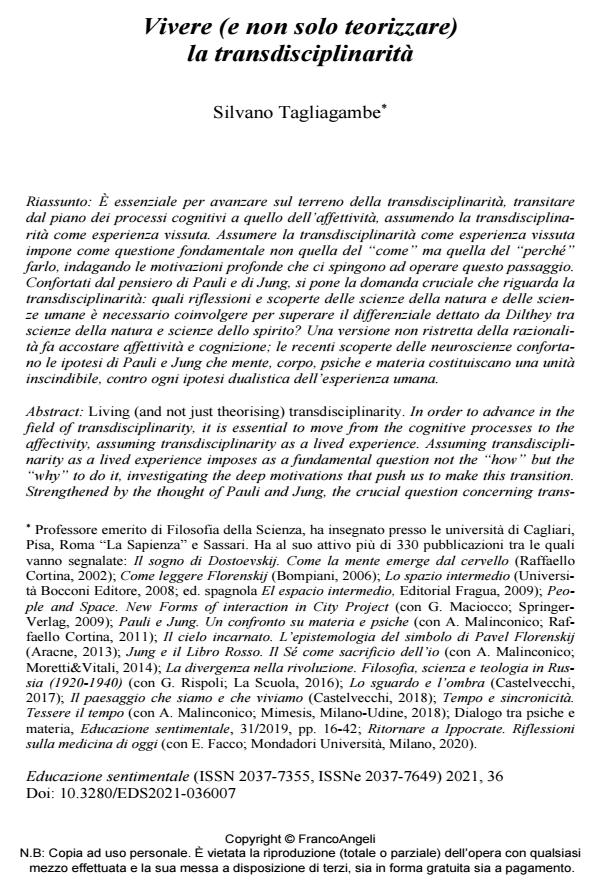Living (and not just theorising) transdisciplinarity
Journal title EDUCAZIONE SENTIMENTALE
Author/s Silvano Tagliagambe
Publishing Year 2022 Issue 2021/36
Language Italian Pages 14 P. 64-77 File size 335 KB
DOI 10.3280/EDS2021-036007
DOI is like a bar code for intellectual property: to have more infomation
click here
Below, you can see the article first page
If you want to buy this article in PDF format, you can do it, following the instructions to buy download credits

FrancoAngeli is member of Publishers International Linking Association, Inc (PILA), a not-for-profit association which run the CrossRef service enabling links to and from online scholarly content.
In order to advance in the field of transdisciplinarity, it is essential to move from the cognitive processes to the affectivity, assuming transdisciplinarity as a lived experience. Assuming transdisciplinarity as a lived experience imposes as a fun-damental question not the "how" but the "why" to do it, investigating the deep motivations that push us to make this transition. Strengthened by the thought of Pauli and Jung, the crucial question concerning transdisciplinarity arises: what reflections and discoveries from the natural sciences and the humanities need to be involved in order to overcome the differential dictated by Dilthey between the natural sciences and the spiritual sciences? A non-restrictive version of rationali-ty brings affectivity and cognition together; the recent discoveries of neurosci-ence support Pauli and Jung’s hypothesis that mind, body, psyche and matter are not mutually exclusive. that mind, body, psyche and matter constitute an insepa-rable unity, against any dualistic hypothesis of human experience.
Keywords: transdisciplinarity, natural sciences, human sciences, affectivity, lived experience, perspective of how, perspective of why, open conception of rationali-ty, inseparable unity of mind and body
- Bellone E. (1980). Il sogno di Galileo. Bologna: il Mulino.
- Jung C.G. (1917/43). Gli archetipi dell’inconscio collettivo. Opere, vol. 7. Torino: Boringhieri, 1983.
- Jung C.G. (1947/54). Riflessioni teoriche sull’essenza della psiche. Opere, vol. 8. Torino: Boringhieri, 1976.
- Jung C.G., Pauli W. (1952). Naturklärung und Psyiche. Zürich: Rascher Verlag.
- Jung C.G., Pauli W. (1992). Wolfgang Pauli und C.G. Jung, Ein Briefwechsel. C.A. Meier, a cura di. Tr. it.: Jung e Pauli. Il carteggio originale: l’incontro tra Psiche e materia. A. Sparzani, A. Panepucci, a ura di. Bergamo: Moretti & Vitali, 2016.
- Merini A. (2004). Poema della croce. Segrate (Mi): Frassinelli.
- Pauli W. (2006). Psiche e natura. G. Trautteur, a cura di. Milano: Adelphi.
- Pauli W. (2006). L’influsso delle immagini archetipiche sulla formazione delle teorie scientifiche di Keplero. Psiche e natura. G. Trautteur, a cura di. Milano: Adelphi.
- Pauli W. (1964). Teoria ed esperimento. Fisica e conoscenza. Torino: Boringhieri.
Silvano Tagliagambe, Vivere (e non solo teorizzare) la transdisciplinarità in "EDUCAZIONE SENTIMENTALE" 36/2021, pp 64-77, DOI: 10.3280/EDS2021-036007